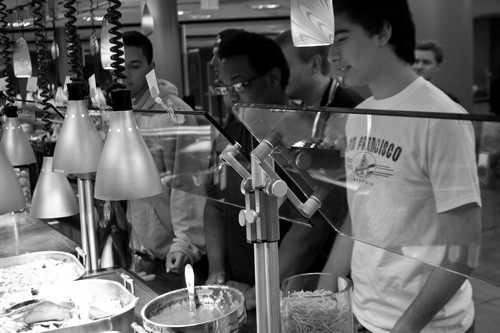
(Spencer Eggers/ The Daily Campus )
When coming to college, many students hear the same sort of stories from parents: make friends, study hard and beware of the cafeteria’s food. However, since the recession began, college students—including ones on the SMU campus have been changing some habits.
According to Julie Wiksten, director of auxiliary services at SMU, one significant difference since the fall of 2008 is an increase in participation in the meal plans that SMU offers.
“More meal plans are being purchased,” she said, “and students are actually using the plans because they’re not going out.”
David Randolph, director of dining services, said that in the past, while students may have purchased meal plans, they would still eat out, spending more money on top of the cost of the meal plan.
Recently, however, students have been using their meal plans, eating the meals at Real Food on Campus instead of hitting a hot spot with friends. Randolph would not provide numbers to show this trend.
“What we’re really seeing an increase is on the late nights and weekends,” he said.
On evenings when students are usually out—going out to dinner with friends or going through the drive through at Taco Bell near midnight—they’re staying on campus and heading to Umphrey Lee. Randolph reasons that this is because students simply have less money.
“I would think that disposable income has gone down for students,” he said. And while there have been more meal plans, there are “less of the premium plans being purchased.”
The basic meal plan for unlimited entry into Umphrey Lee’s cafeteria is $2215 each semester. The premium plan, which includes unlimited entry and 450 additional Flex Dollars (preloaded cash on a student’s SMU ID), costs $2573 each semester.
Tomasz Kwiatkowski, SMU junior, has the basic plan, which is his main source for meals.
“I use it every day,” he said, explaining that while it’s more expensive than purchasing groceries and cooking for oneself, it’s cheaper than eating out.
According to the U.S. Census Bureau Web site, most full-service restaurants serve meals priced between $7 and $10, averaging out to $8.50 a meal. With 119 days in the semester and three meals needed on each of those days, the total is $25.50 a day, and $3,034.50 a semester.
This is assuming students go to these average restaurants. The occasional visit to Sushi Kyoto across from campus on Hillcrest Avenue, where the average price is $10 to $20, can push that figure way up.
The parents of some students have put them on meal plans to solve this extra spending, but some students still refuse to do it.
Kyle Griege, SMU sophomore, falls into this category.
“The number one reason [for having a meal plan] is to cut down on my eating out expenses,” he said.
Griege said that with the expense of the meal plan and how little he uses it, he is not yet saving money. But his parents have plans to change this habit.
Griege’s disposable income had been “cut in half” since nearly August 2009.
They put him on the meal plan this year to reduce extreme spending on food, even though he lives in an apartment nearly five miles away from campus.
While students still see the BMWs in the parking lots and the designer bags on the shoulders of classmates, the recession has at least hit college students’ eating habits.








